This post may contain affiliate links. Please see our disclosure policy for more details.
Introduce salmon to your baby with confidence with these cooking tips, serving suggestions, and easy recipes! Everything you need to know all in one place!
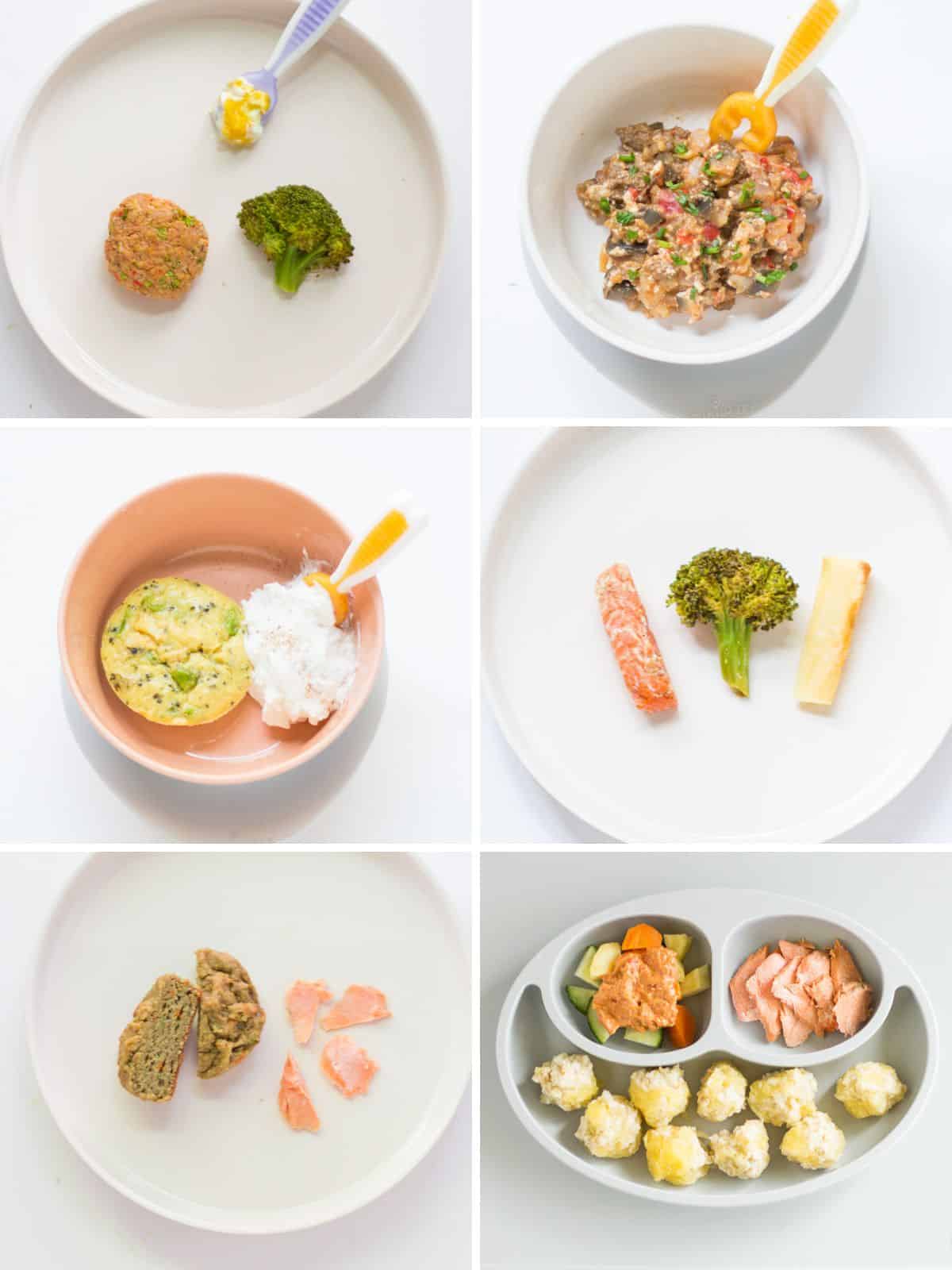
Table of Contents
- When to introduce salmon
- Is salmon safe for babies?
- Introducing Food Allergens to Baby
- Health Benefits
- Buying the best salmon
- Frequently Asked Questions
- How to Cook Salmon For Baby
- How to Serve Salmon
- Storage Suggestions
- 3 Month Meal Plan for Baby Led Feeding
- Salmon Recipes for Baby
- How to Cook Salmon for Babies (3 ways) Recipe
When to introduce salmon
Salmon can be offered to babies as soon as they’re ready to start solids, usually around 6 months. It’s important to remember that your baby is unique and that rather than going by the calendar, you need to make sure your baby is DEVELOPMENTALLY ready to start solids.
If you’re unsure, be sure to grab my FREE handout!
Is salmon safe for babies?
As long as it is cooked properly and served in an age-appropriate way, as I show you here, it is safe. It also contains lower amounts of sodium compared to other fish.
Additionally, it is lower in mercury, making it a great option for pregnant moms and young children. That’s because mercury can negatively impact the fetus and a child’s brain and nervous system.
While it is a safer option, instead of eating salmon all the time, I encourage you to rotate with other low-mercury fish, like halibut and sardines. You will be able to incorporate more variety and help meet your baby and family’s nutritional needs.
Introducing Food Allergens to Baby
Salmon as well as other finned fish are one of the top allergens, and if you were told to wait until around 2-3 years of age to introduce them, this is outdated advice!
The current recommendation is to introduce highly allergenic foods EARLY and OFTEN. By doing so, you can dramatically reduce the risk or actually help prevent the development of food allergies.
When first introducing, start with a small amount. Be sure it’s the only new food on your baby’s plate so that if there is an allergic reaction, you will know what caused it.
Serve it at home early in the day so you can monitor your baby for any reaction(s) and get medical help if necessary.
Health Benefits
Salmon is a great source of many critical nutrients that babies need, such as iron, zinc, and vitamin D (much higher in wild-caught). It is a particularly excellent source of B12 , which is necessary for producing red blood cells, and omega-3 fatty acids, an essential nutrient for proper brain development.
Canned salmon is also a great source of calcium due to the edible bones.
Buying the best salmon
I don’t know about you, but with so many choices out there, buying salmon can feel overwhelming! My goal here is to help you make the best decision according to your needs and values.
Wild-caught vs. Farmed Salmon
Wild-caught:
- Means it caught in its natural environment
- Contains less toxins
- Has a deeper red color
- Has a higher ratio of omega 3 to omega 6 fatty acids. While both are essential, we tend to consume a lot more omega-6 fats and not enough omega-3s
Farmed salmon (may be labeled as Atlantic salmon) contains pollutants, antibiotics, pesticides, and toxins from the fish farms. And depending on its feed, may contain lower amounts of nutrients than wild-caught salmon.
The “downside” to wild-caught salmon is that just like with shrimp, it is overfished. If sustainability is your concern, sockeye, coho, and king salmon from Alaska are great choices, according to the Marine Stewardship Council.
The Monterey Bay Aquarium’s Seafood Watch site is a wonderful resource.
Wild-caught salmon is also more expensive, so if you want to enjoy it regularly and you are on a budget, this may pose a sustainability concern of a different nature.
Fresh vs. Frozen
Unless you are getting the fresh catch of the day from a fish mart, chances are what you find sold as “fresh” salmon at the supermarket isn’t so fresh. Just like with shrimp and most other seafood, it was previously frozen and thawed for sale.
I personally love frozen salmon for the convenience! Also, it is flash frozen right after being caught to preserve freshness and nutrition. I purchase ours from Costco. Their wild-caught Alaskan sockeye salmon is amazing and individually packaged.
Fresh vs. Canned
Canned salmon is a wonderful option. It’s convenient and nutritious. In fact, according to the USDA study, canned pink and red salmon was found to have higher amounts of omega-3 fatty acids than the fresh. It also delivers a powerful punch of calcium.
Just be sure to look for “no salt added” or “low sodium” and BPA free lining.
Frequently Asked Questions
Thawing in the refrigerator overnight is the simplest and safest method.
If you forget, then first remove the fish from its packaging and place into a resealable plastic bag. Then submerge in a large bowl of cold water. Check after 30 minutes, being sure to change out the water every 10 minutes or so to ensure that the temperature remains below 40° at all times.
You don’t need to wash salmon before cooking. In fact, USDA recommends against it as bacteria in the juices can spread to other foods and surfaces. The bacteria will get killed during the cooking process.
On! It helps to hold the shape, allow for more even cooking, and retain juices. You can easily separate the skin once cooked.
Cooking time will depend on the fish’s thickness and the cooking method. Wild-caught salmon also has less fat than farmed salmon so it will take less time to cook.
The best advice I can offer is to use a thermometer. Aim for 140-145°F and be sure to pull the salmon FAST when it reaches temperature as it will continue to cook as it rests.
The salmon should flake easily with a fork and the flesh should appear opaque.
Don’t be alarmed if you see this. It’s due to the protein found in salmon called albumin, which solidifies when heated.
To minimize this white layer, bring the fillets to room temperature before cooking and avoid cooking at high temperature.
How to Cook Salmon For Baby
Regardless of which method you choose,
- Let the salmon come to room temperature. Take your fillets out of the refrigerator about 15 minutes prior to cooking. Don’t let them sit out for too long!
- Be sure to check for any white pin bones running down the center of the fillet.
- Cook until salmon reaches the internal temperature of 140-145°F.
Steamed
Place water in a pot, add steamer basket, and bring to a boil. Add salmon, cover, reduce heat to medium and cook for 5-6 minutes.
Poached
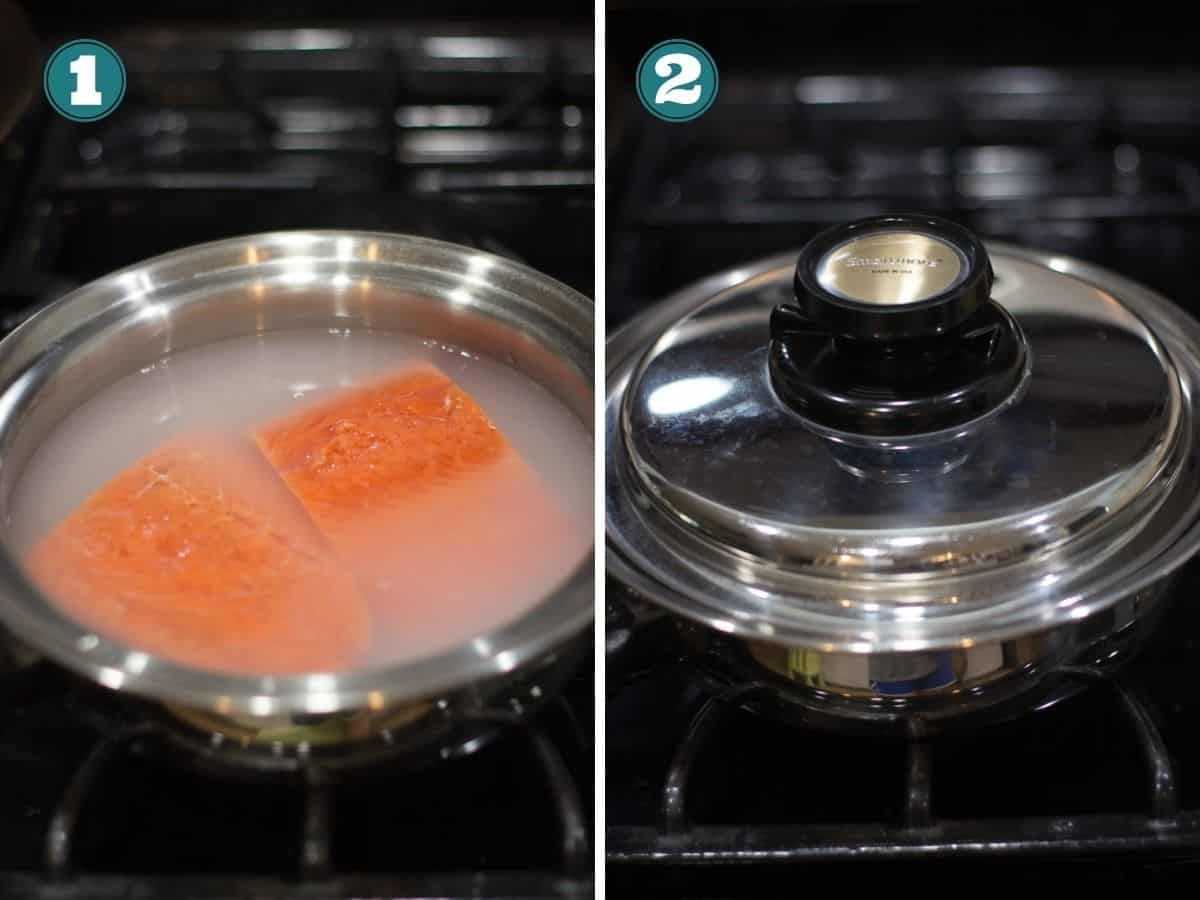
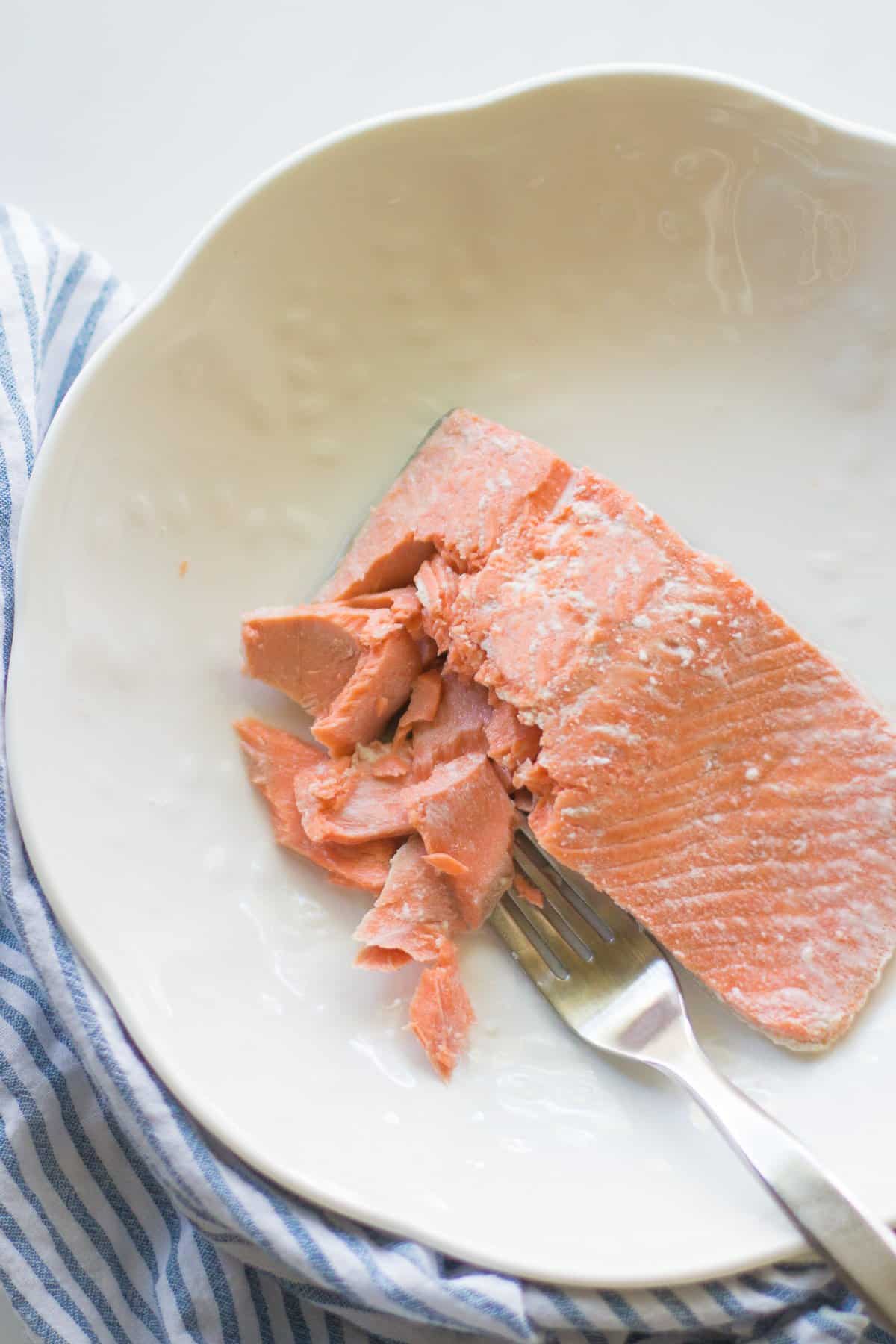
Here are three ways you can poach salmon:
- This method requires minimal prep work.
- Place salmon in a deep skillet skin side down. Add water or broth so it barely covers the fish. Bring to a boil and once liquid starts bubbling, turn off the heat.
- Cover the skillet and let it sit for 10 minutes or so.
- If you want to infuse more flavor into your salmon,
- Add cold water or stock and aromatics of choice (optional), such as dill, onion, celery, to a deep skillet. While I haven’t tried it yet, I’ve heard that poaching in milk is good too.
- Bring to a boil then reduce heat to a gentle simmer.
- Add the salmon skin-side down and cover. Cook for 5-10 minutes, depending on the thickness of the fillet.
- You can also poach in a sauce alongside other ingredients, like this poached cod. Simply substitute with salmon. It’s SO flavorful!
Baked (Steam roasted)
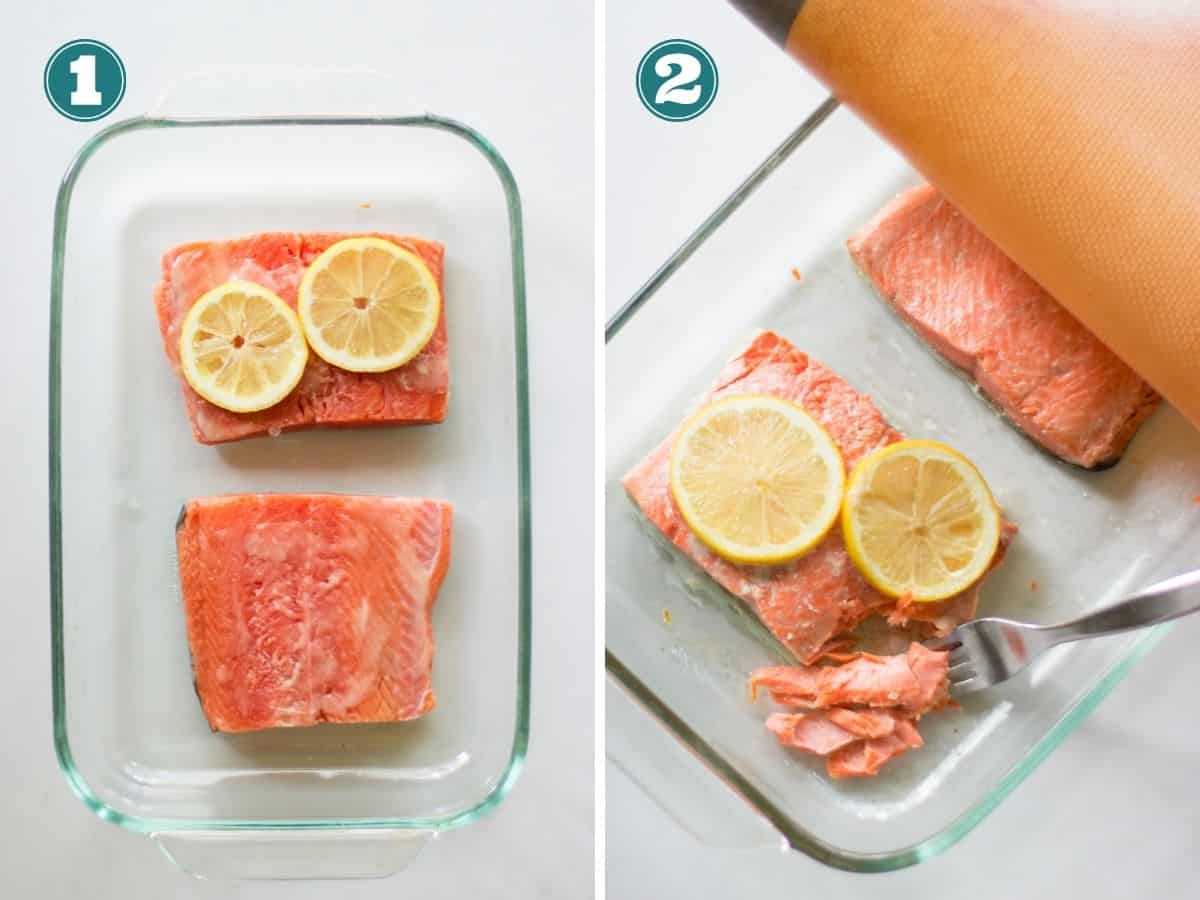
Line a baking pan with parchment paper as stuck-on salmon skin is hard to scrape off. Place salmon on top and season with melted butter or oil and seasoning(s) of choice. I also like to add some lemon wedges.
Cover the pan and bake for about 10-15 minutes, depending on the thickness.
Salmon Cakes
You can use fresh or canned salmon for this. It’s such an easy and delicious way to serve salmon to your baby along with vegetables and spices! These cakes also freeze well.
How to Serve Salmon
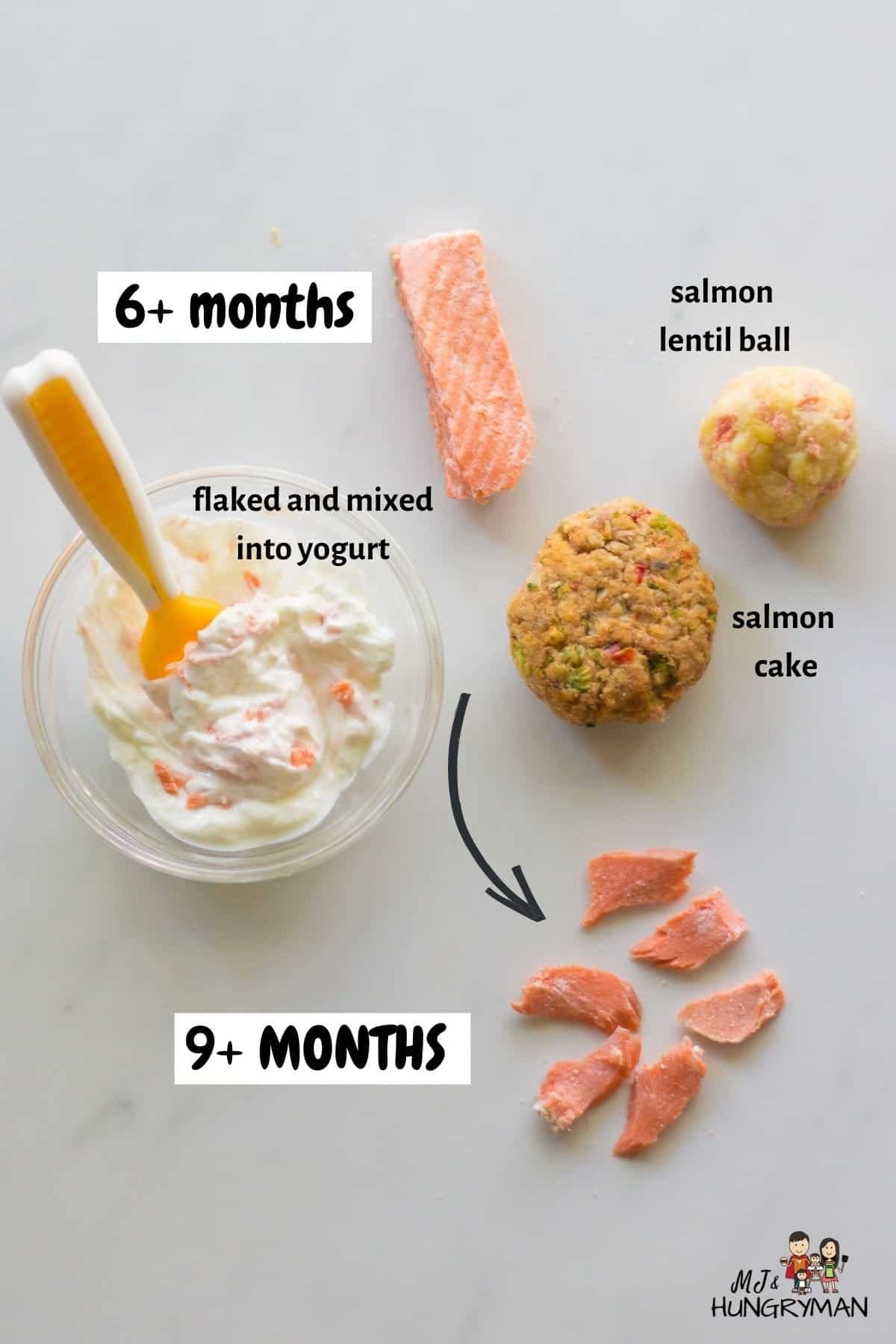
First be sure to carefully inspect the salmon for tiny bones. Even when salmon is labeled as boneless, it is possible to have tiny bones in it.
Once you’ve cooked the salmon using any of the methods mentioned, here’s how to serve it to your baby.
6+ Months Old
- Offer finger-shaped, 1-2 adult finger-width pieces.
- Flake into tiny pieces and add to other foods, such as:
- Salmon cake – offer whole
- Salmon quiche
9+ Months Old
By 8-9 months of age, your baby should develop their pincer grasp and be able to pick up smaller pieces. In addition to all the suggestions above, you can start offering bite-sized pieces.
Storage Suggestions
For uncooked salmon:
- Use fresh salmon within one to two days upon purchase. If the fish is packaged, refer to the packaging for the ‘best before’ date.
- Store unused fresh salmon in a vacuum or airtight freezer bag in the freezer for up to three months.
- Store canned salmon unopened at room temperature for up to three years. Check the ‘best before’ date when purchasing the can.
- Once the can is open, remove the salmon from the can, store it in an airtight container, and use it within three to four days.
Cooked salmon
- Transfer to an airtight container and keep in the refrigerator for up to 3 days.
- To freeze, make sure salmon is completely cooled. Wrap in parchment paper or plastic wrap and place in freezer bags. Squeeze out excess air and freeze for up to 3 months.
3 Month Meal Plan for Baby Led Feeding
Are you:
- getting ready to start or at the beginning stage of introducing solid solids and feeling overwhelmed?
- stuck on purees and having a really difficult time transitioning to table food?
- or tired of serving the same foods on repeat and want to offer more variety of foods to your older baby or toddler?
If so, my 3 MONTH Baby Led Feeding Journey Program may be just what you are looking for!
It’s a complete roadmap that would show you through daily videos and photos of what foods and how to serve them to your baby AND the rest of the family at the same time. Everything you need to know all in one place!

Do you want to minimize picky eating and set a solid foundation for a lifetime of healthy eating habits?
Check out this 3 month mastering self-feeding program! It’s the closest thing to me being in your kitchen
Salmon Recipes for Baby
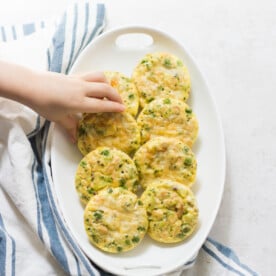
Mini crustless quiche

Teriyaki glazed salmon

Easy Salmon Bean Salad
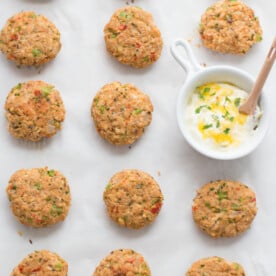
Mini Baked Canned Salmon Patties

Baked Salmon Balls
Did you make this recipe? Leave a rating below and let me know how you liked the recipe! Your feedback means so much to me!

How to Cook Salmon for Babies (3 ways)
Equipment
Ingredients
- 2 (8-10 ounce) salmon fillets, skin on
- Oil or butter (for baked)
- Optional: seasonings, lemon wedges, aromamtics
Instructions
Steamed
- Place water in a pot, add steamer basket, and bring to a boil. Add salmon, cover, reduce heat to medium and cook for 5-6 minutes.
Poached (two ways)
- Place salmon in a deep skillet skin side down. Add water or broth so it barely covers the fish. Bring to a boil and once liquid starts bubbling, turn off the heat.Cover the skillet and let it sit for 10 minutes or so.
- If you want to infuse more flavor into your salmon – add cold water or stock and aromatics of choice, such as dill, onion, celery, to a deep skillet .Bring to a boil then reduce heat to a gentle simmer. Add the salmon skin-side down and cover. Cook for 5-10 minutes, depending on the thickness of the fillet.
Baked (steam roasted)
- Line a baking pan with parchment paper as stuck-on salmon skin is hard to scrape off. Place salmon on top and season with melted butter or oil and seasoning(s) of choice. I also like to add some lemon wedges.Cover the pan and bake at 400*F for about 10-15 minutes, depending on the thickness.
Notes
- Cooking time will depend on the fish’s thickness and the cooking method. Wild-caught salmon also has less fat than farmed salmon so it will take less time to cook. Be sure to read the “How to cook salmon for babies” section for more details!
- Storage:
- Transfer to an airtight container and keep in the refrigerator for up to 3 days.
- To freeze, make sure salmon is completely cooled. Wrap in parchment paper or plastic wrap and place in freezer bags. Squeeze out excess air and freeze for up to 3 months.

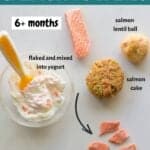



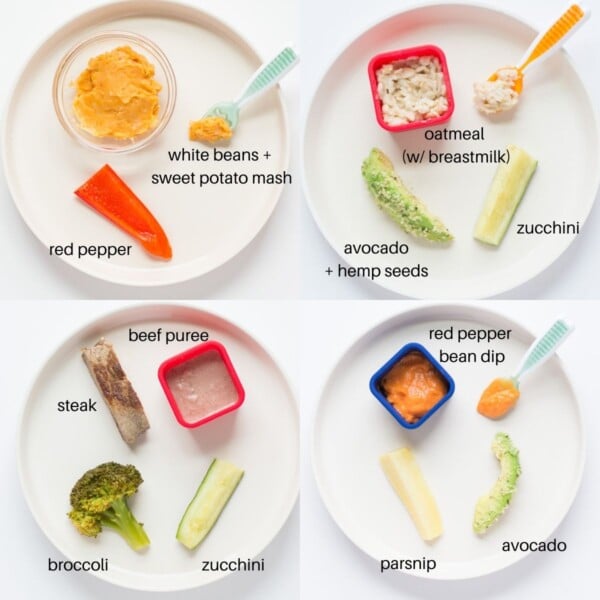









What temperature for the steam roasting?
Hi!! At 400°F! Thanks for bringing this to my attention just added to the recipe card :).